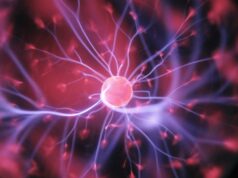
As a principal investigator for the pivotal VNS-REHAB study, which supported the first US Food and Drug Administration (FDA) premarket approval of a vagus nerve stimulation (VNS) system for stroke rehabilitation therapy last year, Jesse Dawson (Glasgow, UK) is playing a key role in evaluating the potential held by neuromodulation for post-stroke recovery. Here, Dawson outlines the promising future proffered by this technology, and others.
There are a number of exciting developments in this space. Neuromodulation as a concept is well-suited to use during both the acute and rehabilitation phases after stroke. Broadly speaking, neuromodulation involves the alteration of nerve activity through targeted delivery of a stimulus, which could be either electrical or a drug.
There are numerous advantages to this approach. First of all, the stimulus can be highly targeted and delivered to a specific nerve, and—in the case of electrical stimulation—it can be highly reversible and very specifically timed. There is also ease of dose optimisation and the potential for direct measurement of whether the required response is being elicited. Further, there is the potential for closed-loop systems, where the stimulation is delivered in response to an input, such as that from an electroencephalography (EEG) system or perhaps even a brain-computer interface (BCI).
In recent years, randomised controlled trials of VNS paired with rehabilitation, transcranial magnetic stimulation (TMS), transcranial direct current stimulation (tDCS), pharyngeal electrical stimulation and sphenopalatine ganglion stimulation in people with stroke have been reported.
The use of VNS paired with rehabilitation has recently been approved by the US FDA for the treatment of chronic upper-limb deficits after ischaemic stroke. A recent randomised, phase 3 trial showed that this technique led to improvements in upper-extremity impairment and function in people with moderate-to-severe arm weakness an average of three years after ischaemic stroke. A clinically meaningful response—defined as an improvement greater than or equal to six points on the Fugl-Meyer assessment, upper limb (FMA-UE)—was seen in approximately half of people treated with VNS compared to approximately a quarter of people treated with rehabilitation alone.
However, several questions regarding implementation of the technique in clinical services remain. These include whether the technique is of use for people with intracerebral haemorrhage (ICH) or in people with the most severe arm weakness. And, cost-effectiveness data are also lacking. In addition, high-quality randomised studies of non-invasive VNS are needed.
So far, trials of TMS- and tDCS-based approaches in stroke rehabilitation have not demonstrated improved clinical outcomes, despite promising experimental evidence showing effects on plasticity and learning. Pharyngeal electrical stimulation may improve symptoms of dysphagia and facilitate decannulation following tracheostomy. This will now be studied further in wider groups of patients in large clinical trials.
A further, very promising technique is the use of sphenopalatine ganglion stimulation. The sphenopalatine ganglion is a large parasympathetic ganglion, located in the pterygopalatine fossa, posterior to the middle turbinate. Post-ganglionic parasympathetic fibres travel with the trigeminal nerve to provide vasomotor input to the anterior circulation, including meningeal and dural vessels. Sphenopalatine ganglion stimulation therefore aims to enhance collateral blood flow in the anterior intracerebral circulation. Post hoc analyses from a large trial suggest this may improve functional outcome in people with cortical ischaemic stroke who do not receive thrombolytic therapy and who receive the optimal amount of stimulation.
In summary, this is a really interesting and exciting area, with one technique already approved by a major regulatory body. There is still much to learn about how to optimise these techniques both in terms of their use, such as stimulation parameters, and of course patient selection. I am very confident, however, that further breakthroughs will happen in the coming years.
Jesse Dawson is a professor of Stroke Medicine at the Institute of Cardiovascular and Medical Sciences, and associate at the School of Medicine, Dentistry and Nursing, at the University of Glasgow in Glasgow, UK. He is also a consultant physician in the Queen Elizabeth University Hospital, the clinical lead for the Scottish Stroke Research Network, and chaired the 2021 European Stroke Organisation Conference (ESOC).
DISCLOSURES: Dawson was a principal investigator for the VNS-REHAB study—a randomised, blinded, pivotal device trial evaluating the Vivistim system (MicroTransponder).













